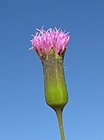Note: This is a project under development. The articles on this wiki are just being initiated and broadly incomplete. You can Help creating new pages.
Difference between revisions of "Emilia sonchifolia - Sasasruti"
(→Identification) |
|||
| Line 35: | Line 35: | ||
==Identification== | ==Identification== | ||
===Leaf=== | ===Leaf=== | ||
| − | {{Leaf|Pinnatifid| | + | {{Leaf|Pinnatifid|Alternate|Leaves radical and cauline; radical leaves 4-10 x 1-3 cm, lyrate-pinnatifid with large terminal lobes, semi-orbicular.}}<ref name="Leaf"/> |
===Flower=== | ===Flower=== | ||
| − | {{Flower|Bisexual| | + | {{Flower|Bisexual|Corymbose heads|Pink|10|3-3.5 mm long, wider to the mouth, lobes 5. Stamens 5; anthers 1-1.5 mm long. Ovary c. 1.5 mm long; style-arms acute. }} |
===Fruit=== | ===Fruit=== | ||
Revision as of 12:19, 4 May 2020
Sasaruti is a small herb in the aster family. Tiny pink flowers are borne on long stems. A common weed in the tropics where it has traditional medicinal uses and also provides an edible leaf.
Contents
- 1 Uses
- 2 Parts Used
- 3 Chemical Composition
- 4 Common names
- 5 Properties
- 6 Habit
- 7 Identification
- 8 List of Ayurvedic medicine in which the herb is used
- 9 Where to get the saplings
- 10 Mode of Propagation
- 11 How to plant/cultivate
- 12 Commonly seen growing in areas
- 13 Photo Gallery
- 14 References
- 15 External Links
Uses
Conjunctivitis, Worm infestations , Tonsilitis, Bleeding piles, Hemorrhoids, Ulcers [1]
Parts Used
Chemical Composition
Common names
| Language | Common name |
|---|---|
| Kannada | Elikivi gida, Elikivisoppu, Ili kivi gida, Jumki hoo |
| Hindi | hirankuri, kirankuri |
| Malayalam | Muel-schevi, mulshevi, muyalccevi |
| Tamil | muel-schevy, mayarcevi, muyalccevi |
| Telugu | |
| Marathi | NA |
| Gujarathi | NA |
| Punjabi | NA |
| Kashmiri | NA |
| Sanskrit | udiram-panum, sasasruti, sasasrutih |
| English |
Properties
Reference: Dravya - Substance, Rasa - Taste, Guna - Qualities, Veerya - Potency, Vipaka - Post-digesion effect, Karma - Pharmacological activity, Prabhava - Therepeutics.
Dravya
Rasa
Tikta (Bitter), Katu (Pungent), Kashaya (Astringent)
Guna
Laghu (Light)
Veerya
Sheeta (cold)
Vipaka
Karma
Kapha, Vata
Prabhava
Habit
Identification
Leaf
| Kind | Shape | Feature |
|---|---|---|
| Pinnatifid | Alternate | Leaves radical and cauline; radical leaves 4-10 x 1-3 cm, lyrate-pinnatifid with large terminal lobes, semi-orbicular. |
Flower
| Type | Size | Color and composition | Stamen | More information |
|---|---|---|---|---|
| Bisexual | Corymbose heads | Pink | 10 | 3-3.5 mm long, wider to the mouth, lobes 5. Stamens 5; anthers 1-1.5 mm long. Ovary c. 1.5 mm long; style-arms acute. |
Fruit
| Type | Size | Mass | Appearance | Seeds | More information |
|---|---|---|---|---|---|
| Achene | 1-2 mm | 5-ribbed, hispid; pappus white silky, 5-6 mm long. | {{{6}}} |
Other features
List of Ayurvedic medicine in which the herb is used
Where to get the saplings
Mode of Propagation
How to plant/cultivate
An easily grown plant, succeeding in most well-drained soils in a sunny position. Plants flower better when growing on nutritionally poor soils, producing much lusher growth on rich soils. [4]
Commonly seen growing in areas
Photo Gallery
References
External Links
- Ayurvedic Herbs known to be helpful to treat Conjunctivitis
- Ayurvedic Herbs known to be helpful to treat Worm infestations
- Ayurvedic Herbs known to be helpful to treat Tonsilitis
- Ayurvedic Herbs known to be helpful to treat Bleeding piles
- Ayurvedic Herbs known to be helpful to treat Hemorrhoids
- Ayurvedic Herbs known to be helpful to treat Ulcers
- Herbs with Flowers used in medicine
- Herbs with Leaves used in medicine
- Herbs with Stem used in medicine
- Herbs with Root used in medicine
- Herbs with common name in Kannada
- Herbs with common name in Hindi
- Herbs with common name in Malayalam
- Herbs with common name in Tamil
- Herbs with common name in Sanskrit
- Habit - Herb
- Index of Plants which can be propagated by Seeds
- Herbs that are commonly seen in the region of Tropical area
- Herbs
- Herb
- Asteraceae




